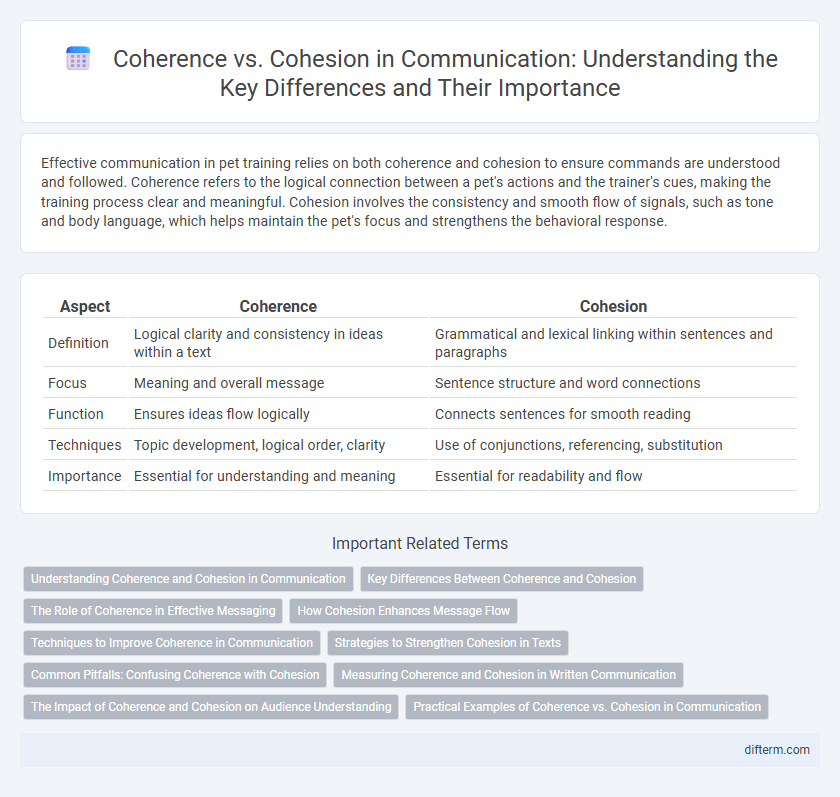Effective communication in pet training relies on both coherence and cohesion to ensure commands are understood and followed. Coherence refers to the logical connection between a pet's actions and the trainer's cues, making the training process clear and meaningful. Cohesion involves the consistency and smooth flow of signals, such as tone and body language, which helps maintain the pet's focus and strengthens the behavioral response.
Table of Comparison
| Aspect | Coherence | Cohesion |
|---|---|---|
| Definition | Logical clarity and consistency in ideas within a text | Grammatical and lexical linking within sentences and paragraphs |
| Focus | Meaning and overall message | Sentence structure and word connections |
| Function | Ensures ideas flow logically | Connects sentences for smooth reading |
| Techniques | Topic development, logical order, clarity | Use of conjunctions, referencing, substitution |
| Importance | Essential for understanding and meaning | Essential for readability and flow |
Understanding Coherence and Cohesion in Communication
Coherence in communication refers to the logical flow and clarity of ideas, ensuring the message is easily understood by the audience. Cohesion involves the use of linguistic devices such as pronouns, conjunctions, and transitional phrases that link sentences and ideas together. Mastering both coherence and cohesion enhances overall communication effectiveness by facilitating clear and connected discourse.
Key Differences Between Coherence and Cohesion
Coherence refers to the logical flow and clarity of ideas in communication, ensuring that the message is easily understood by the audience. Cohesion involves the linguistic elements, such as conjunctions and pronouns, that link sentences and paragraphs together smoothly. The key difference lies in coherence focusing on overall meaning and organization, while cohesion deals with the surface connections within the text.
The Role of Coherence in Effective Messaging
Coherence ensures that communication maintains a clear and logical flow, allowing the audience to easily follow and understand the message. It integrates ideas meaningfully, enhancing the overall clarity and impact of the content. Effective messaging relies on coherence to create a unified and persuasive narrative that resonates with the receiver.
How Cohesion Enhances Message Flow
Cohesion enhances message flow by linking sentences and ideas through linguistic devices such as conjunctions, pronouns, and lexical repetition, creating clear connections that guide the reader smoothly from one point to the next. This seamless connectivity reduces ambiguity and cognitive load, allowing the audience to grasp the intended meaning effortlessly. Effective cohesion ensures that communication remains fluid, supporting coherence without sacrificing clarity or depth.
Techniques to Improve Coherence in Communication
Techniques to improve coherence in communication include clear organization of ideas through logical sequencing and the use of consistent thematic elements. Employing topic sentences, transitional phrases that naturally guide the reader, and parallel structures enhances the flow and clarity of messages. Repeating key terms and maintaining a clear focus on the central theme ensures that communication remains unified and easily understood.
Strategies to Strengthen Cohesion in Texts
Employing lexical repetition and using synonyms help reinforce cohesion by creating clear connections between sentences. Incorporating transitional phrases and conjunctions guides readers through the text's logical flow, enhancing overall coherence. Consistent reference with pronouns and demonstratives also binds ideas tightly, supporting seamless understanding.
Common Pitfalls: Confusing Coherence with Cohesion
Confusing coherence with cohesion often leads to communication breakdowns, as coherence pertains to the overall logical flow and clarity of ideas, while cohesion refers to the linguistic links within sentences and paragraphs. Many writers mistakenly rely heavily on cohesion devices such as conjunctions and transition words, assuming these guarantee coherence without ensuring the underlying ideas connect meaningfully. Effective communication requires balancing cohesive elements with coherent content to maintain reader understanding and engagement.
Measuring Coherence and Cohesion in Written Communication
Measuring coherence in written communication involves assessing the logical flow and clarity of ideas, ensuring each sentence contributes meaningfully to the overall message. Cohesion is evaluated by analyzing linguistic elements such as conjunctions, pronouns, and transitional phrases that link sentences and paragraphs. Effective measurement combines qualitative judgment with tools like text analysis software to quantify connectivity and thematic consistency.
The Impact of Coherence and Cohesion on Audience Understanding
Coherence ensures the logical flow of ideas, enabling the audience to grasp the overall message effortlessly, while cohesion connects sentences through consistent use of pronouns, conjunctions, and transitions, enhancing clarity and readability. High levels of coherence and cohesion in communication reduce cognitive load, allowing audiences to process information more efficiently and maintain engagement. Research shows that texts with strong coherence and cohesion significantly improve comprehension and retention rates across diverse audiences.
Practical Examples of Coherence vs. Cohesion in Communication
Coherence in communication ensures ideas flow logically, such as when a speaker clearly outlines main points supported by relevant details, making the message easy to follow. Cohesion uses linguistic devices like pronouns, conjunctions, and transitional phrases to link sentences smoothly, as seen in effective email writing where sentence connectors maintain clarity. Practical examples highlight that coherence organizes content meaningfully, while cohesion provides the grammatical glue that connects ideas within the message.
coherence vs cohesion Infographic

 difterm.com
difterm.com